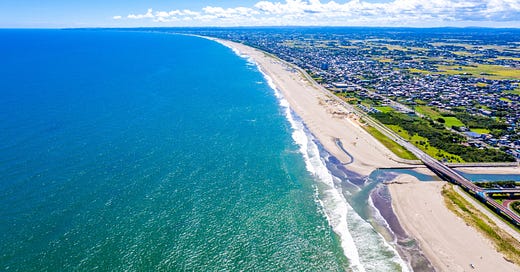I pushed my Toyota “Jimi” north along the coastal Sotobo Highway from the southern tip of Chiba to Lake Kasumigaura in Ibaraki Prefecture. It’s only a two-lane road, prone to clots on a weekend, but this was a Tuesday and there was little to hold down my speed.
Despite the mid-October date, the sky was bright with the towering cumulus clouds you’d more likely see in Okinawa than in central Japan.
The Pacific was on the right, moving into and out of view as Jimi rolled up Chiba’s long peninsula town to town. The villages in these parts look delicate, as if constructed of paper and glue. I muttered “just waiting for the next tsunami” as I passed the exposed homes and inns.
About 30 minutes south of the Ibaraki border the highway opens out to a 60-kilometer stretch of straight white beach and low coastal sand dunes called Kujuku-ri. The name is actually an archaic measurement meaning “99 ri long.” If you want to know how long a ri is, do the algebra. I can’t.
For all its (considerable!) ecological shortcomings, Japan does an admirable job of protecting its coast lines when it wants to. Kujuku-ri is an ideal example.
Facing north, the right side of this beach highway stretches all the way to the sea untouched—developments are forbidden and only the occasional dirt foot path to the shore is visible. This is not a place that an e-billionaire can simply plop down some cash for a dream home blocking his less fortunate neighbors. Better yet, the sand too is free of snack shops, life guard towers, trash cans, bike paths, volleyball courts, or any other development county commissioners the world over tend to green light.
I’ve often described Kujuku-ri to friends as like the last scene of Planet of the Apes. Taylor sees the ruins of the Statue of Liberty and he realizes he is on Earth. He falls to his knees on the desolate beach, sets his jaw, and growls…
You maniacs! You finally blew it up! Damn you!
Sorry. Boomer moment.
I was getting hungry so started looking to the inland side of the highway for a restaurant or café that grabbed my eye. “Burger” shop signs abound. In fact, the word burger was all I was seeing.
I’ve been told Kujuku-ri is the Kanto area’s best known surf spot. And indeed, like a Huntington or Doheny, illegally parked surf vans and wet-suited teenagers and twenty-somethings mill about here. Fifty burger shops per mile make sense with those demographics.
Unfortunately I wasn’t in the mood for beef. I pulled over near a random line of shops and homes to check Google maps and found that Topa Tacos was top rated for the vicinity. After a couple of missed turns I found the joint—barely more than a kitchen—operating out of a weather-beaten old home by the side of the highway.
Let me be more accurate. The kitchen is a lean-to shack set down in the parking lot. The sun-crisped main house is piled with so much junk it can’t be entered and will likely fall down at the next gust of wind.
Fumie Kawamoto is Peruvian Japanese and she runs Topa Tacos alone in the kitchen shack. She’s maybe early thirties, and her face is deeply tanned with smooth, but tightening skin. Life on the sunny highway looks like it agrees with her, but it is taking its toll.
Fumie came to Japan 20 years ago when her family moved here as part of an immigration-boosting work visa program. I recently learned the visas attracted many South Americans of Japanese ancestry but failed to keep the vast majority longer term as Japan’s fortunes declined and more promising economies beckoned abroad.
I ordered a single seafood taco with extra jalapeno. However, what came to my wood table off the parking lot was instead a giant, tightly wrapped burrito. Turns out Tapo isn’t in the business of tacos.
The thickly packed tube was as hefty as a D-cell flashlight. Maybe it was because I just came off a two-hour drive, but this was one fine burrito. Simple, stewed, melty, and with just enough jalapeno tang to keep me licking my fingers and plowing through the starchy mess to the end.
Before leaving Topa I asked Fumie if I could use the rest room. Her older Japanese husband had come to join her in the kitchen shack for a few quick chores and he said, “Toilet broken. Please use Family Mart about 2 kilometers down the road.”
As I turned back to Jimi to head for the convenience store, he called out. “Actually, back there outside would be fine too…if you want.” He thumbed over his shoulder to the empty weed lot behind the house. I thanked him and trotted over.
I thought about the Kawamotos for quite some time as I returned to the road to complete my day trip. There was something about the couple’s light touch—their willingness to look me in the eye and engage. We were only an hour outside Tokyo on the coast, yet these two seem completely disengaged from those metro confines. They were selling burritos for a few bucks each in a falling down home…a stone’s throw from the sands and then the waves beyond. And they both seemed happy.
I’m going to go out on a limb and guess surfing is what brought the Kawamotos to Kujuku-ri, and it’s the burritos that help them stay.







You’re back - good.
Nothing like a good burrito!